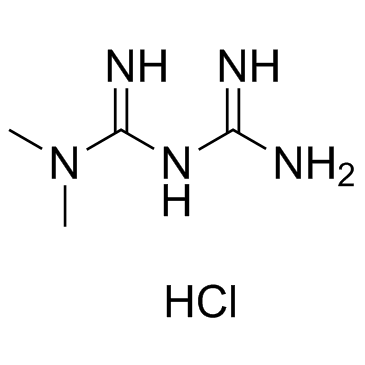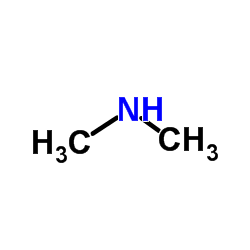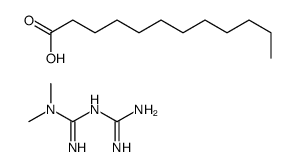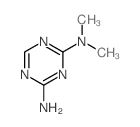Metformin

Metformin structure
|
Common Name | Metformin | ||
|---|---|---|---|---|
| CAS Number | 657-24-9 | Molecular Weight | 129.164 | |
| Density | 1.0743 | Boiling Point | 229.23°C | |
| Molecular Formula | C4H11N5 | Melting Point | 199-200 °C | |
| MSDS | N/A | Flash Point | 58.1±22.6 °C | |
Use of MetforminMetformin (1,1-Dimethylbiguanide) inhibits the mitochondrial respiratory chain in the liver, leading to activation of AMPK, enhancing insulin sensitivity for type 2 diabetes research. Metformin can cross the blood-brain barrier and triggers autophagy[1]. |
| Name | metformin |
|---|---|
| Synonym | More Synonyms |
| Description | Metformin (1,1-Dimethylbiguanide) inhibits the mitochondrial respiratory chain in the liver, leading to activation of AMPK, enhancing insulin sensitivity for type 2 diabetes research. Metformin can cross the blood-brain barrier and triggers autophagy[1]. |
|---|---|
| Related Catalog | |
| Target |
AMPK |
| In Vitro | Metformin (1,1-Dimethylbiguanide) inhibits proliferation of ESCs in a concentration-dependent manner. The IC50 is 2.45 mM for A-ESCs and 7.87 mM for N-ESCs. Metformin shows pronounced effects on activation of AMPK signaling in A-ESCs from secretory phase than in cells from proliferative phase[3]. Metformin (0-500 μM) decreases glycogen synthesis in a dose-dependent manner with an IC50 value of 196.5 μM in cultured rat hepatocytes[4]. Metformin shows cell viability and cytotoxic effects on PC-3 cells with IC50 of 5 mM[5]. |
| In Vivo | Metformin (1,1-Dimethylbiguanide; 100 mg/kg, p.o.) alone, and metformin (25, 50, 100 mg/kg) with isoproterenol groups attenuates myocyte necrosis through histopathological analysis[1]. Metformin (> 900 mg/kg/day, p.o.) results in moribundity/mortality and clinical signs of toxicity in Crl:CD(SD) rats[2]. |
| References |
| Density | 1.0743 |
|---|---|
| Boiling Point | 229.23°C |
| Melting Point | 199-200 °C |
| Molecular Formula | C4H11N5 |
| Molecular Weight | 129.164 |
| Flash Point | 58.1±22.6 °C |
| Exact Mass | 129.101440 |
| PSA | 88.99000 |
| LogP | -2.31 |
| Appearance of Characters | Solid,White to Light Brown |
| Vapour Pressure | 1.3±0.3 mmHg at 25°C |
| Index of Refraction | 1.576 |
| InChIKey | XZWYZXLIPXDOLR-UHFFFAOYSA-N |
| SMILES | CN(C)C(=N)N=C(N)N |
| Water Solubility | Acetonitrile (Slightly), Aqueous Acid (Slightly), Dichloromethane (Slightly), DM |
CHEMICAL IDENTIFICATION
HEALTH HAZARD DATAACUTE TOXICITY DATA
MUTATION DATA
|
|
~10% 
Metformin CAS#:657-24-9 |
| Literature: Veisi, Hojat; Khazaei, Ardeshir; Safaei, Maryam; Kordestani, Davood Journal of Molecular Catalysis A: Chemical, 2014 , vol. 382, p. 106 - 113 |
|
~% 
Metformin CAS#:657-24-9 |
| Literature: Journal of Molecular Structure, , vol. 996, # 1-3 p. 38 - 41 |
|
~% 
Metformin CAS#:657-24-9 |
| Literature: WO2010/100337 A1, ; Page/Page column 9 ; |
|
~% 
Metformin CAS#:657-24-9 |
| Literature: WO2010/100337 A1, ; Page/Page column 9-10 ; |
|
~% 
Metformin CAS#:657-24-9 |
| Literature: Journal of the Chemical Society, , p. 1252,1255 |
|
~% 
Metformin CAS#:657-24-9 |
| Literature: Chemische Berichte, , vol. 62, p. 1394 Journal of the Chemical Society, , vol. 121, p. 1793 |
|
~% 
Metformin CAS#:657-24-9 |
| Literature: Chemische Berichte, , vol. 62, p. 1394 Journal of the Chemical Society, , vol. 121, p. 1793 |
| Fluamine |
| N'-dimethylguanylguanidine |
| N,N-dimethylimidodicarbonimidic diamide |
| Diabex |
| N,N-dimethyl-biguanide |
| N,N-dimethylbiguanidine |
| 1,1-Dimethylbiguanide |
| Metiguanide |
| Metforminum |
| Glumetza |
| Dimethylbiguanide |
| 3-(diaminomethylidene)-1,1-dimethylguanidine |
| EINECS 211-517-8 |
| Diabetosan |
| Glucophage |





 CAS#:851069-42-6
CAS#:851069-42-6 CAS#:55474-79-8
CAS#:55474-79-8 CAS#:4039-98-9
CAS#:4039-98-9